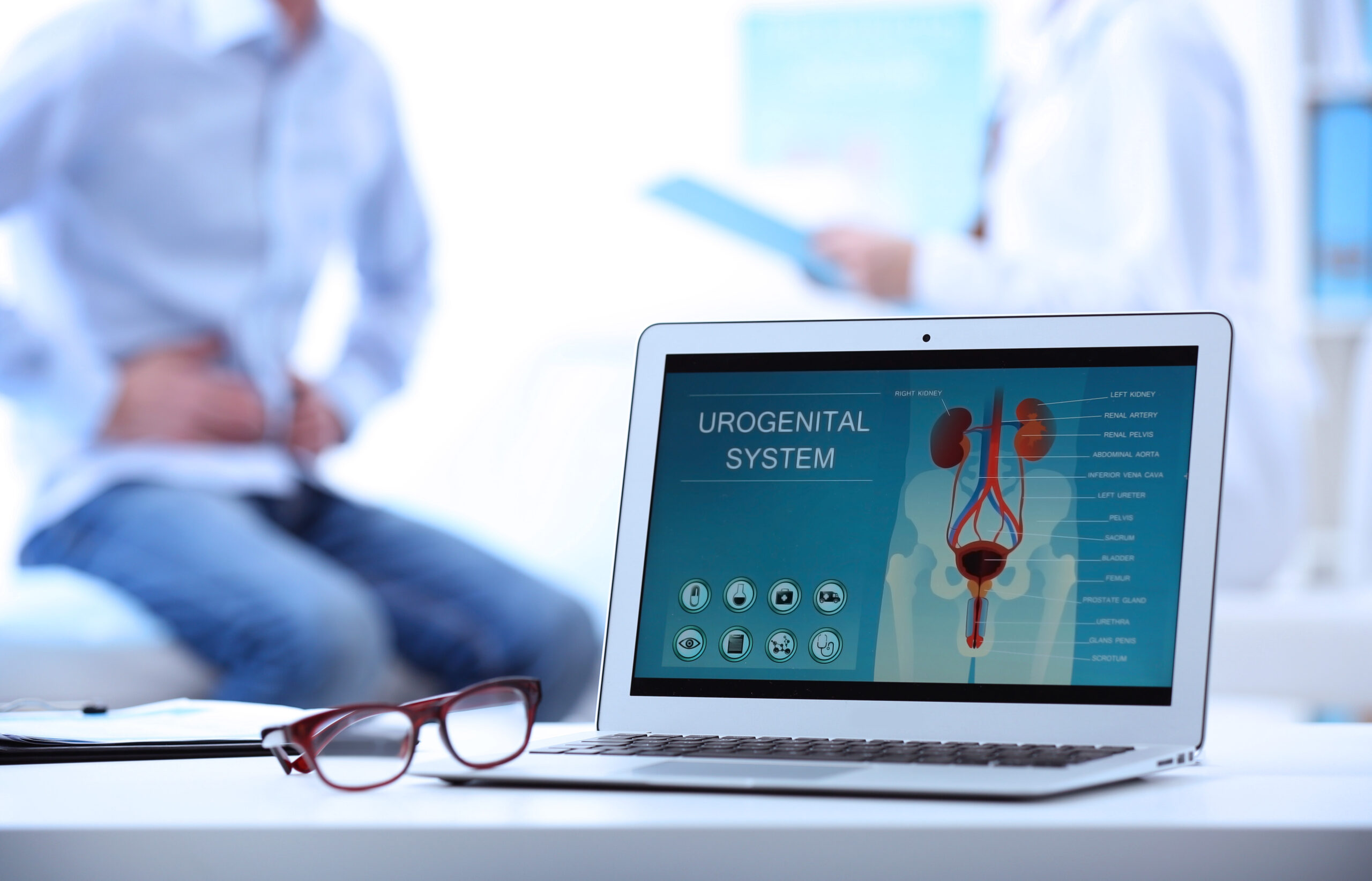Radiation therapy for prostate cancer is highly effective, but it can cause urinary side effects for some patients. If you’re experiencing issues like frequent urination, urgency, or discomfort while urinating during or after treatment, you’re not alone – these symptoms are common and usually manageable. In most cases, urinary side effects peak toward the end of radiation and improve in the weeks or months after treatment. Here we discuss why these symptoms occur and how to manage urinary side effects so you can maintain your quality of life during prostate cancer treatment.
Why Does Radiation Therapy Affect Urination?
During prostate radiation therapy, nearby normal tissues – especially the bladder and urethra – can become inflamed. This radiation-induced inflammation of the bladder lining is known as radiation cystitis. It can make you feel like you have to urinate more often or very suddenly, and may cause a burning sensation when you pee. You might notice symptoms such as:
- Increased frequency and urgency: needing to urinate more than usual, including waking up at night (nocturia).
- Dysuria: pain or a burning feeling when urinating.
- Weak stream or difficulty starting: treatment can sometimes cause swelling or scarring in the urethra, slowing urine flow.
- Incontinence (rare): an inability to fully control urine is uncommon after radiation (more often an issue after surgery), but a small number of men may experience leakage
These effects happen because the prostate sits very close to the bladder and urethra. Radiation that targets the prostate can irritate these areas, especially toward the end of a treatment course when the cumulative dose is higher. The good news is radiation cystitis is typically temporary – it tends to worsen during treatment and shortly afterward, then gradually get better as the tissues heal. In a few men, urinary issues might arise or persist later (months or years post-treatment), but most patients see improvement within a few weeks. Always let your doctor know about your urinary symptoms, particularly if you notice cloudy or foul-smelling urine, as that could be a sign of a urinary infection that needs treatment.
Tips for Managing Urinary Symptoms
You don’t have to just “live with” urinary side effects – there are many strategies to help relieve discomfort and improve bladder control. Here are some effective ways to manage these symptoms:
- Stay Hydrated (but Time Your Fluids): Don’t skimp on water – drinking plenty of fluids actually helps by diluting urine and keeping your bladder healthy. Aim for about 6–8 glasses (around 2 liters) of water spread through the day. However, you may want to limit liquids a couple hours before bed to cut down on nighttime trips to the bathroom. Keeping urine dilute can reduce irritation, but avoiding late-night drinks can help you sleep better with less interruption.
- Avoid Bladder Irritants: Certain drinks and foods can aggravate the bladder. Try to cut down on caffeine (coffee, black or green tea, many sodas) and limit alcohol – these can increase urine production and irritate the bladder lining. Similarly, acidic juices (like orange or grapefruit juice) and fizzy carbonated drinks may worsen burning or urgency. Everyone is different, so notice if specific items bother you. You might experiment by reducing these and seeing if your symptoms improve. (Note: Some people think cranberry juice helps; research isn’t conclusive, and it may actually irritate the bladder in some cases. If you enjoy it and it doesn’t worsen symptoms – and you’re not on warfarin – it could be okay in moderation.)
- Practice Pelvic Floor Exercises: Kegel exercises, which strengthen the pelvic floor muscles, can be very useful for regaining urinary control. These exercises target the muscles that help start and stop urine flow. Studies show that men who do pelvic floor exercises can reduce urine leakage and improve continence. It’s a good idea to begin these exercises before treatment (as a preventive measure) and continue them after treatment if you have any leakage. Even a few sets of Kegels a day can make a difference over time in improving bladder control.
- Bladder Training: In addition to Kegels, so-called bladder training techniques may help if you’re needing to urinate very frequently. This involves gradually extending the time between bathroom visits to “retrain” your bladder to hold more urine. Keep a diary of when you urinate, then slowly try to increase the interval between trips, if feasible. Over weeks, this can improve urgency and frequency issues. Of course, don’t overstretch your comfort – increase times gradually and get guidance from your doctor or nurse if needed.
- Medications: Consult with your doctor about medications that can ease urinary symptoms. Alpha-blockers (like tamsulosin/Flomax) relax the smooth muscles in the prostate and bladder neck, helping urine flow more easily. These are often given during and after radiation to counteract any narrowing of the urethra. Other drugs, such as certain anticholinergic medications, can calm an overactive bladder and reduce that “gotta go now” feeling. Which medication (if any) is appropriate depends on your specific symptoms – your physician will tailor recommendations to you. Don’t hesitate to ask about this; a short course of medication can significantly improve comfort for many men.
- Avoid Constipation: It may surprise you, but constipation can actually worsen urinary problems. A full bowel presses on the bladder, making urgency or retention more likely. To avoid this, maintain a diet high in fiber (fruits, vegetables, whole grains) and consider a stool softener if your doctor recommends one. Staying active with light exercise can also keep your bowels regular, which in turn can relieve pressure on your bladder. By keeping constipation at bay, you remove one more aggravating factor for your urinary tract.
- Plan Rest and Bathroom Breaks: Fatigue can affect muscle tone, so it’s wise to rest when needed, especially in the afternoon or after radiation sessions. A short rest can help the muscles around your bladder recover and function better. Also, consider scheduling regular bathroom trips (even before you feel an intense urge) to avoid rushing in panic. Timed voiding – going every 2 hours, for example – may preempt accidents if urgency is an issue. Over time, you’ll find a rhythm that works best for you.
Above all, keep the conversation open with your healthcare team. If you are having any of these symptoms after brachytherapy, please call your WRO coordinator so you can speak directly to Dr. Ankit Agarwal, Dr. Steve Kurtzman, or Dr. John Shumway. We may offer solutions such as prescription medicines to help reduce your symptoms. In some cases, we may refer you to your urologist to help manage any symptoms. Rarely, after prostate brachytherapy, patients can develop urinary retention. Knowing this, don’t hesitate to seek medical help if you ever find you can’t urinate at all or have severe pain in the lower abdomen – get to an ER promptly in that case.
Looking Ahead: Support and Recovery
The silver lining is that for most men, urinary side effects from prostate radiation are temporary and manageable. They often start to subside within a month or two after finishing therapy, especially with the measures described above. As time passes, you should notice gradual improvement in frequency, urgency, and comfort. Many men return to their baseline urinary habits within 3–6 months post-treatment, if not sooner. Every patient is different, though – if you had pre-existing urinary issues (like an enlarged prostate causing slow flow) those might take a bit longer or require ongoing management.
Remember that your care team is here to help you through this process. At Western Radiation Oncology, our physicians (Dr. Steven Kurtzman, Dr. Ankit Agarwal, Dr. John Shumway, and colleagues) have decades of experience in prostate cancer care. We understand the urinary side effects that can come with treatment and, just as importantly, we know how to help patients minimize and cope with these symptoms. From day one, we take steps to protect your urinary function – for example, using advanced techniques to limit radiation dose to the bladder and urethra, and employing innovations like rectal spacing to shield nearby tissues. If you report increased urinary frequency or burning, we can promptly recommend interventions (whether lifestyle tweaks, medications, or adjustments to your treatment plan) to address it.
Living well during and after prostate cancer treatment is very much possible. By following the strategies outlined – staying hydrated, avoiding irritants, doing your exercises, and partnering with your doctors – you can keep urinary side effects under control. Most men find that these symptoms are worst during the treatment weeks and then steadily get better. Be patient with yourself during this time and celebrate the small improvements. If something isn’t working for you, let us know – often a simple change can provide relief.
In the end, successfully treating your prostate cancer is the top goal, and a few urinary hassles along the way are usually manageable with the right care. We’re here for you every step of the way. Don’t be embarrassed to talk about urinary issues – we address these concerns all the time, and there’s no reason to suffer in silence. With open communication and proactive management, you can focus on healing and getting back to normal life after cancer.
If you’re a prostate cancer patient in the San Francisco Bay Area, Southern California (Palm Desert and beyond), Michigan, or Tennessee and have questions about prostate cancer management or treatment side effects, don’t hesitate to reach out to us at Western Radiation Oncology. Our supportive team is ready to help you make the best decision for your prostate cancer treatment, so you can confidently continue your cancer fight and recovery.

